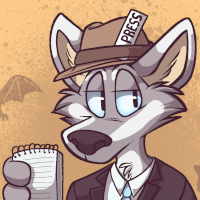Escape from St. Arned, by Rose LaCroix – book review by Fred Patten.
by Patch O'Furr
Submitted by Fred Patten, Furry’s favorite historian and reviewer.
Escape from St. Arned, by Rose LaCroix
Dallas, TX, FurPlanet Productions, September 2014, trade paperback $9.95 (143 pages).
This title is a work of anthropomorphic fiction for adult readers only.
As LaCroix’s Basecraft Cirrostratus (June 2010) ended, Elor (Prof. Elor Kaya, cougar), Vinz (Vinz Nivariya, wolf), and Laz (Y’Lazde Malek, fox) appeared to have escaped from the despotism of Occidentania, and hiding in its lawless Basecraft Cirrostratus giant flying airbase, to the freedom of a new life in Riverlea in neighboring Lyocia. But as Escape from St. Arnaud opens a year later, everything is suddenly falling apart for them.
Elor loses his new college job when Occidentania’s old false charges of immorality against him reach Lyocia, and the rumors of immorality make it impossible to get a new job. Also, crimelord Hannock Burrad’s gang from the Cirrostratus is trying to kill him. But the rival criminal gang of Kerro (stoat), which has relocated in Lyocia and is supplying weapons to all the factions in Occidentania, offers to protect Elor and give him a job if he will deliver a shipment for them. Meanwhile, Hannock’s goons rough up Laz while looking for Elor, and the hot-tempered Vinz blames the cougar for his lover’s being hurt. When Laz sides with Elor, Vinz storms out. Then Laz leaves Elor for a different long-term job.





 This anthology of 16 original furry horror stories was published to debut at Midwest FurFest 2014 on December 5-7. Each story has a full-page frontispiece by Silent Ravyn. To quote FurPlanet’s blurb:
This anthology of 16 original furry horror stories was published to debut at Midwest FurFest 2014 on December 5-7. Each story has a full-page frontispiece by Silent Ravyn. To quote FurPlanet’s blurb:



